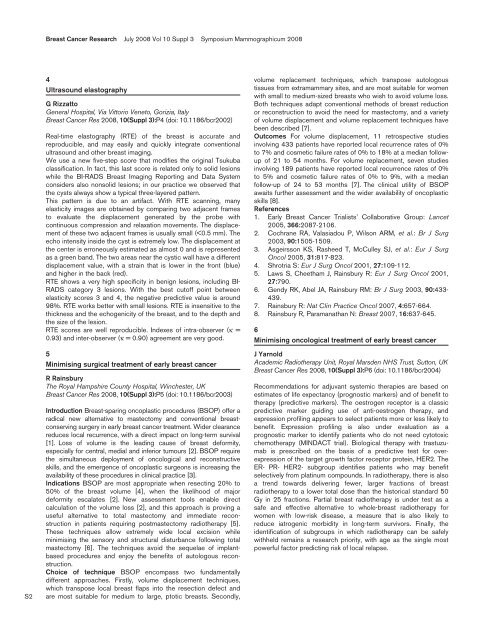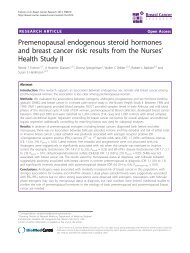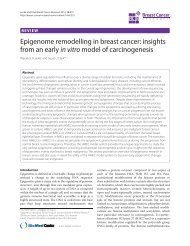<strong>Breast</strong> <strong>Cancer</strong> Research July 2008 Vol 10 Suppl 3 Symposium Mammographicum 2008 S2 4 <strong>Ultrasound</strong> elastography G Rizzatto General Hospital, Via Vittorio Veneto, Gorizia, Italy <strong>Breast</strong> <strong>Cancer</strong> Res 2008, 10(Suppl 3):P4 (doi: 10.1186/bcr2002) Real-time elastography (RTE) of the breast is accurate and reproducible, and may easily and quickly integrate conventional ultrasound and other breast imaging. We use a new five-step s<strong>core</strong> that modifies the original Tsukuba classification. In fact, this last s<strong>core</strong> is related only to solid lesions while the BI-RADS <strong>Breast</strong> Imaging Reporting and Data System considers also nonsolid lesions; in our practice we observed that the cysts always show a typical three-layered pattern. This pattern is due to an artifact. With RTE scanning, many elasticity images are obtained by comparing two adjacent frames to evaluate the displacement generated by the probe with continuous compression and relaxation movements. The displacement of these two adjacent frames is usually small (
Available online http://breast-cancer-research.com/supplements/10/S3 7 Promoting early presentation of breast cancer AJ Ramirez <strong>Cancer</strong> Research UK London Psychosocial Group, King’s College London, UK <strong>Breast</strong> <strong>Cancer</strong> Res 2008, 10(Suppl 3):P7 (doi: 10.1186/bcr2005) Amongst patients with breast cancer there is strong evidence that delays in excess of 3 months between onset of symptoms and diagnosis/treatment are associated with worse survival rates than shorter delays. The predominant risk factors for patient delays in breast cancer include lack of awareness that breast symptoms could be due to cancer and lack of awareness of personal risk. Ideally an intervention to reduce delayed presentation of breast cancer would promote early help-seeking behaviour by patients at high risk of having cancer, but would not promote anxiety amongst people at low risk. It is important that patients should not be made unnecessarily anxious, and nor should general practitioners be overburdened with consultations with the worried well population. Based on the empirical evidence for the risk factors for patient delay and using effective behavioural change techniques, we have developed and are evaluating a psycho-educational intervention to promote early presentation of breast cancer by older women. We have focused our intervention on older women who are at greater risk of breast cancer and are also more likely to delay their presentation. The intervention is delivered by trained diagnostic radiographers at the point when the women leave the routine protection afforded by the National Health Service <strong>Breast</strong> Screening Programme and is in line with government recommended practice and complementary to the <strong>Breast</strong> Screening Programme. The ultimate aim of the intervention is to reduce the proportion of older women with breast cancer who delay their presentation, and thereby save lives. I will outline this work and other current initiatives within the United Kingdom to promote awareness and early presentation of breast cancer and how these might inform the development of policy initiatives to improve outcomes for patients within the National Health Service. 8 Magnetic resonance imaging of ductal carcinoma in situ C Kuhl Department of Radiology, University of Bonn, Germany <strong>Breast</strong> <strong>Cancer</strong> Res 2008, 10(Suppl 3):P8 (doi: 10.1186/bcr2006) Intraductal cancer or ductal carcinoma in situ (DCIS) has been considered a mammographic disease. Before the advent of mammographic screening, only about 2% to 5% of breast cancers were diagnosed in the intraductal stage. Magnetic resonance imaging (MRI) has traditionally been considered insensitive for DCIS. More recent studies, however, suggest that, with appropriate diagnostic criteria, contrast-enhanced MRI may be a very sensitive tool for diagnosing DCIS, especially high-grade DCIS. In addition, MRI has been shown to be superior to delineate the intraductal extension of invasive cancers – another reason why preoperative staging with MRI is important. The likelihood with which the mammographic diagnosis of DCIS or DCIS components fails does not correlate with mammographic breast density – in other words, a missed mammographic diagnosis of DCIS is also conceivable in women with involuted breast. The present lecture summarizes the current level of evidence, and discusses the clinical implications of these findings. 9 Introduction to proton ( 1 H) magnetic resonance spectroscopy of the breast L Bartella Eastside Diagnostic Imaging, Manhattan, New York, USA <strong>Breast</strong> <strong>Cancer</strong> Res 2008, 10(Suppl 3):P9 (doi: 10.1186/bcr2007) Proton magnetic resonance spectroscopy ( 1 H MRS) provides biochemical information about the tissue under investigation. The diagnostic value of 1 H MRS in cancer is typically based on the detection of elevated levels of choline compounds, which is a marker of active tumor [1]. <strong>Breast</strong> 1 H MRS is performed on a clinical magnet of 1.5 T or higher in field strength. A four or more channel breast coil is also needed, just as for imaging. The most widely used technique is the single voxel technique, which is limited to scan one lesion at a time. Magnetic resonance spectroscopic imaging provides information about the spatial distribution of metabolites and is useful for studying multiple lesions [2,3]. The two main potential clinical applications of 1 H MRS include its use as an adjunct to breast MRI to improve the specificity in differentiating benign from malignant lesions and in monitoring or even predicting response to treatment in patients undergoing neoadjuvant chemotherapy. Studies have suggested that 1 H MRS may decrease the number of benign biopsies recommended by MRI [4,5]. Also, in patients undergoing neoadjuvant chemotherapy, 1 H MRS may be able to predict response as early as 24 hours after the first dose [6]. Currently, several limitations exist that make the technique premature for clinical use [7]. Preliminary data are promising, warranting further evaluation with larger, preferably multicenter, trials. References 1. Negendank W: Studies of human tumors by MRS: a review. NMR Biomed 1992, 5:303-324. 2. Hu J, Vartanian SA, Xuan Y, Latif Z, Soulen RL: An improved 1 H magnetic resonance spectroscopic imaging technique for the human breast: preliminary results. Magn Reson Imaging 2005, 23:571-576. 3. Jacobs MA, Barker PB, Bottomley PA, Bhujwalla Z, Bluemke DA: Proton magnetic resonance spectroscopic imaging of human breast cancer: a preliminary study. J Magn Reson Imaging 2004, 19:68-75. 4. Bartella L, Morris EA, Dershaw DD, et al.: Proton MR spectroscopy with choline peak as malignancy marker improves positive predictive value for breast cancer diagnosis: preliminary study. Radiology 2006, 239:686-692. 5. Bartella L, Thakur SB, Morris EA, et al.: Enhancing non mass lesions in the breast: evaluation with proton ( 1 H) MR spectroscopy. Radiology 2007, 245:80-87. 6. Meisamy S, Bolan PJ, Baker EH, et al.: Neoadjuvant chemotherapy of locally advanced breast cancer: predicting response with in vivo 1H MR spectroscopy: a pilot study at 4T. Radiology 2004, 233:424-431. 7. Bartella L, Huang W: Proton MR spectroscopy ( 1 H MRS) of the breast. Radiographics 2007, 27:S241-S252. 10 Magnetic resonance imaging in breast cancer: results of the COMICE trial L Turnbull Centre for MR Investigation, Hull Royal Infirmary, Hull, UK <strong>Breast</strong> <strong>Cancer</strong> Res 2008, 10(Suppl 3):P10 (doi: 10.1186/bcr2008) The role of the addition of magnetic resonance imaging (MRI) to routine techniques for lo<strong>core</strong>gional staging of primary breast S3






